Japan
Wood Products Prices
Dollar Exchange Rates of 25th
October
2020
Japan Yen 104.85
Reports From Japan
Prime Minister makes priority trip to
Viet Nam and
Indonesia
Most newly appointed Japanese Prime Ministers make the
US their first overseas destination the cement the longstanding
strategic partnership between the two countries.
However, Japan¡¯s new PM opted to focus his first
overseas mission on Asia with visits to Vietnam and
Indonesia.
This, say analysts, was in response to the changing
geopolitical situation in the region especially with Chinese
activities in the South China Seas. The purpose was to
promote the Japanese policy of securing a ¡°a free and open
Indo-Pacific region.¡± Vietnam is central to this policy as,
like Japan, it has territorial issues with China.
The other purpose was to advance the reopening of
business travel between the two countries. In meetings
with the Indonesian President the focus was on expanding
exports and providing assistance to Indonesian efforts to
revive the economy.
See:
https://www3.nhk.or.jp/nhkworld/en/news/backstories/1340/
Stimulus supports economy
A government report in October painted a more optimistic
view of economic prospects saying strengthening demand
for electrical items and higher spending on domestic travel
is helping revive the economy but cautioned the economy
is facing severe risks due to the coronavirus pandemic and
associated control measures. The Japanese economy
suffered its worst postwar contraction in the second
quarter of this year.
In related news, the Japanese government is considering
an additional economic stimulus in an effort to boost
consumption and officials have been charged with
developing new ideas to be included in the government's
third supplementary budget for fiscal 2020.
The media anticipate that the ¡®Go-To¡¯ campaigns for
domestic tourists, through which the government subsidies
part of the costs of domestic tourist trips and dining out
will encourage consumption. In addition, some
adjustments to taxes are being considered.
Household spending declines further
The Ministry of Internal Affairs and Communications has
reported that household spending fell for an 11th
consecutive month in August as consumers struggled to
return to their pre-pandemic purchasing habits. Household
spending declined around 7% in August from a year
earlier. However, the pace of decline has slowed after
hitting a 16% high in May at the height of the lockdown.
In related news consumer prices fell for the second
consecutive month in September driven down by weak
demand. This will be a continual problem in a country
already in recession.
Japan's October consumer confidence marked a second
rise reflecting the early signs of economic recovery from
the disruption caused by the pandemic.
The index assessing economic expectations in the next six
months improved but the pace of recovery slowed
compared to the previous month. On willingness to buy
durable goods the index also improved on levels in
September.
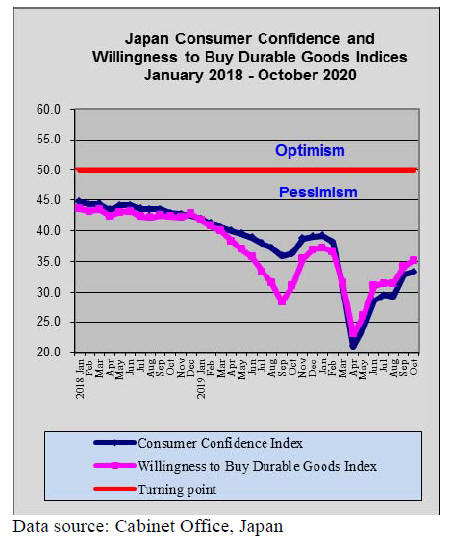
Recovery in exports to China
The pace of decline in Japan¡¯s exports eased in September,
a sign that the pandemic¡¯s impact on global trade is easing.
The Ministry of Finance said value of Japan¡¯s September
exports declined 4.9% from a year earlier, much better
than the almost 15% decline in year on year exports in
August. Most of this improvement was the result of a
recovery in China but analysts warn China¡¯s growth rate
will be impacted by what is happening in the rest of the
world.
During the six months up to September exports declined
over 35%, the sharpest drop since the global financial
crisis.
The main problem for the Japanese government is that the
pandemic is making Japanese companies cautious about
hiring, improving wage growth and investment.
Yen/dollar steady despite rising uncertainty
Rising Covid-19 infections in the US and Europe, the
failure of the US to settle on fresh stimulus measures and
uncertainty over how the US election will turn out are
currently driving risk aversion in currency markets.
Towards the end of October the yen strengthened
moderately, much less than could be expected during
times of growing uncertainty.
At around yen 104+ to the US dollar the yen has exhibited
remarkable stability after a turbulent first quarter.
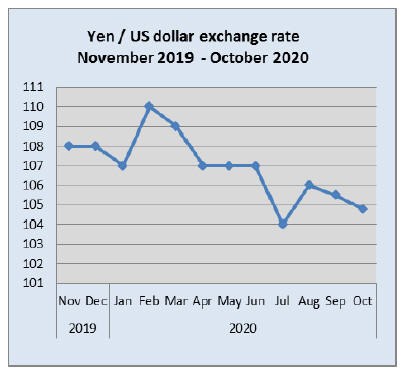
Builder¡¯s confidence dented as orders slip
Data from the Ministry of Land, Infrastructure, Transport
and Tourism shows that housing starts declined almost
10% year-on-year in September following a 9% fall in
August.
Projections of annualised starts dropped to 815,000 in
September from 819,000 in August. Data also showed that
construction orders received by the big 50 contractors fell
in September after an increase in August.
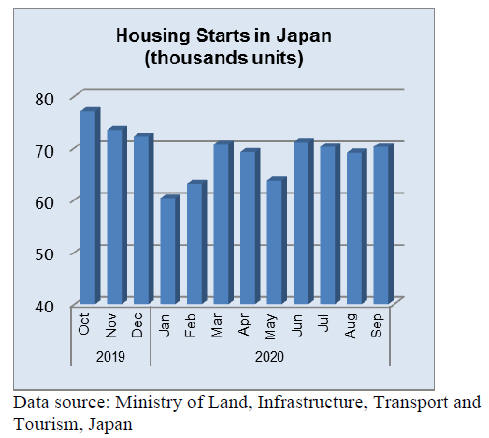
Import update
Wooden door imports
August is holiday month in Japan and construction activity
is down to about 2 weeks in the month. Given the slow
August building activity one could have expected a drop in
imports of housing components such as doors in the
preceding months but this was not apparent. However
there was a decline in the value of wooden door imports in
August.
Year on year door (HS441820) imports dropped 28% and
compared to July imports in August were down around
20%.
As in previous months the main shippers of wooden doors
to Japan were China (58% of August imports) the US 23%
and Malaysia 5%, an improvement on shipments delivered
to Japan in July.
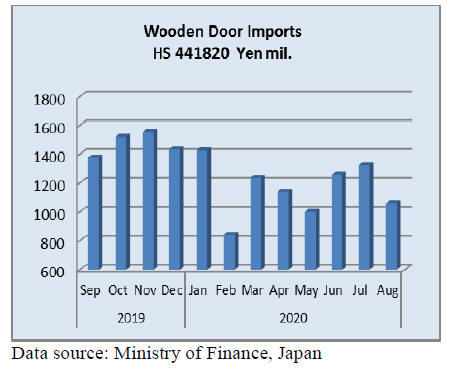
Wooden window imports
Japan¡¯s imports of wooden windows (HS441810) have
turned out to be erotic during the first 8 months of this
year.
The steady increase in the value of window imports that
began in May collapsed in August with year on year
import values falling 34% and month on month import
values declined 19%.
In August the two shippers of wooden windows to Japan,
China and the US saw market share fall to around 70%,
down from over 80% in July. The new comer, the
Philippines secured a 14% of Japan¡¯s imports.
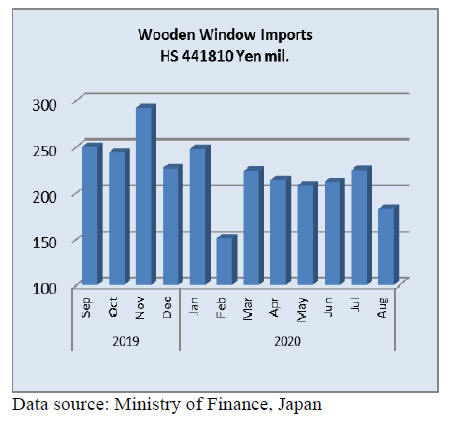
Assembled wooden flooring imports
Of the various categories of flooring imported HS 441875
accounted for 73% of August imports as it has done in past
months and was supplied mainly by shippers in China and
Vietnam.
Shipments of assembled flooring from China accounted
for around 40% of all assembled flooring imports with a
further 16% coming from both Malaysia and Vietnam.
Year on year assembled flooring (HS441871-79) dropped
17% but month on month were unchanged from July.
Ignoring the peaks and dips in the value of imports there
has been a steady decline since the beginning of the year.
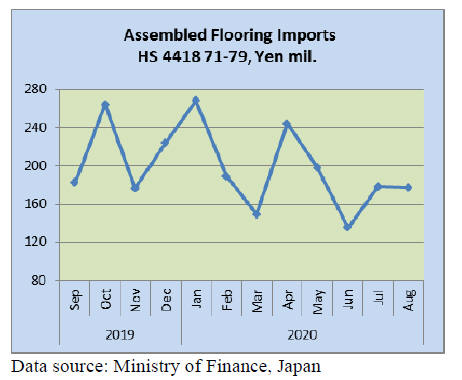
Plywood imports
After sustaining plywood shipments to Japan as the two
main shippers, Indonesia and Malaysia experienced a
decline in demand in July. In August shipments from
China dropped around 35% to just 6,600 cu.m. In contrast,
plywood shipments to Japan from both Indonesia and
Malaysia rose slightly month on month in August. But this
good news was dampened by the 18% year on year decline
in August plywood shipments to Japan. Except for July,
plywood shipments from Vietnam to Japan exceeded that
from China.
Of the various categories reported HS441231 accounted
for over 70% of imports with a further 5% each being of
HS441233 and HS441234.
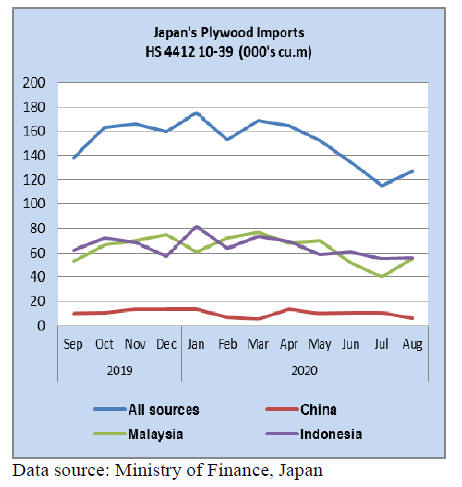 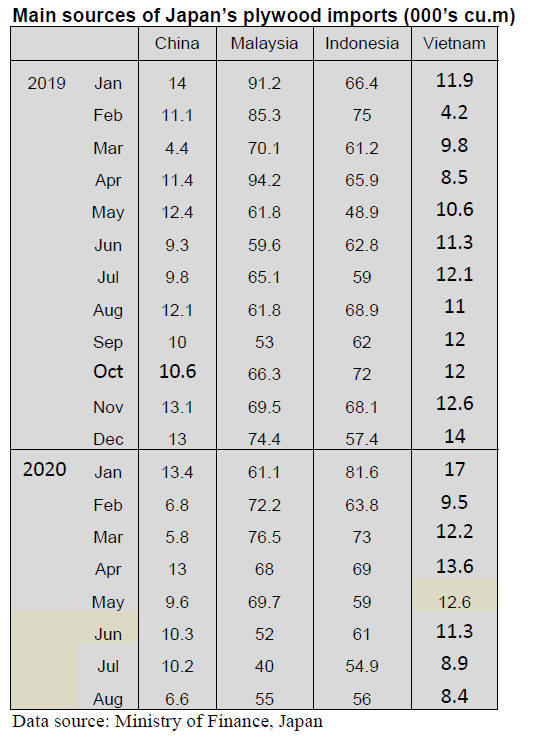
Trade news from the Japan Lumber Reports
(JLR)
The Japan Lumber Reports (JLR), a subscription trade
journal published every two weeks in English, is
generously allowing the ITTO Tropical Timber Market
Report to reproduce news on the Japanese market
precisely as it appears in the JLR.
For the JLR report please see:
https://jfpj.jp/japan_lumber_reports/
South Sea (tropical) logs and lumber
Arrivals of South Sea logs have been low but demand for
both plywood and lumber is weak, there is no shortage.
Plywood mills continue production cutback with weak
demand. Because of corona virus epidemic, large
gathering is prohibitive so many large events are
cancelled, which results in drop of demand of plywood for
stage and related facilities.
In hardwood lumber, movement of laminated free board is
stagnant. There were some spike of demand in late August
but it declined again after demand for public facilities and
reform of stores died down.
Among lumber, movement of decking lumber is active
probably because demand of suburban houses gets busy
due to work from home is becoming popular now.
Russia further tightens wood export
It is reported that the president Puchin of Russia instructed
the government to ban export of unprocessed softwood
logs and high grade hardwood totally since January 2022.
This is nothing new because export duty of Russian Far
East softwood logs is set at 80% since 2021. This was
decided back in 2018.
The objective is to promote higher processing of logs. By
this instruction of the government will come up with new
measures to restrict wood export.
The president also mentioned to stop illegal logging
strictly. System to keep track of harvest, processing and
ship-out (export) will be made to have high traceability.
Also the government helps investment to make higher
processing wood to small business. These measures targets
to close loop holes of illegal wood trading on border of
China, where many illegal acts or crimes are overlooked
by the Russian local governments for quick revenue.
Japan imported 105,000 cbms of softwood logs and 2,400
cbms of hardwood logs in 2019. China imported 7,553,000
cbms of Russian logs, 28% less than 2018. After Russia
bans log export totally, China needs to buy lumber instead
or look for other sources of this much logs. China bought
18,342,000 cbms of Russian lumber in 2019, which is
record high volume. This new measures will impact China
much more than Japan.
Wood demand in 2019
Total wood demand in 2019 was 81,905,000 cbms, 0.7%
less than 2018, which is the first decline in four years
since 2015. While wood demand for fuel increased by
15.1% with 10,386,000 cbms, demand of industrial wood
decreased by 2.6% with 71,269,000 cbms. For industrial
wood demand, imported wood decreased by 4.1% while
domestic wood demand is 0.5% more so that selfsufficiency
rate of industrial wood moved up by 1.0 point
at 33%.
Self-sufficiency rate of total wood including fuel wood
increased by 1.2 points at 37%. This is the highest rate in
34 years since 1985.
Decrease of industrial wood demand continued for
last
two years. In 2018, increase of fuel wood demand covered
shortfall of industrial wood demand so total wood demand
was more than 2017 but because of drop of industrial
wood demand is so much in 2019, even with increase of
fuel wood demand, total is less than 2018.
In industrial wood demand, logs for lumber manufacturing
is 1.7% less than 2018. Logs for plywood manufacturing is
4.8% less. Reason is housing starts in 2019 is 4% less than
2018. In particular, wood based units decreased by 16,075
units. In logs for both lumber and plywood manufacturing,
imported logs decreased but domestic logs increased so
the self-sufficiency rate moved up. The rate of logs for
lumber increased to 51%. Domestic logs for plywood
manufacturing increased by 4.5 points so the rate is now
45.3%.
The largest drop of industrial wood is logs for pulp and
paper manufacturing, which takes about 40% of industrial
wood. Both imported and domestic materials decreased at
31,061,000 cbms, 3.0% less. Self -sufficiency rate dropped
by 0.9 points to 15%. This hampers increase of selfsufficiency
rate of total industrial wood. Reason is
decrease of paper demand by decrease of total population
and progress of electronic devises. In 2020, paper demand
further declines by corona virus incident.
Increase of fuel wood demand is by rapid expansion of
wood biomass power generation plants. It started
increasing since 2014 and this is the first time that the volume reached
10,000,000 cbms. Imported wood for fuel in 2019 is
3,454,000 cbms, 24.6% more than 2018 while domestic
wood is 6,932,000 cbms,10.9% more.
Volume of imports is only half of domestic wood but rate
of increase of imported wood for fuel is far higher so selfsufficiency
rate dropped by 2.6 points. Majority of
imported fuel wood is wood pellet. There are 78 more
power plants, which are authorized but have not started yet
so once these start operating, 15,000,000 cbms of wood
pellet will be imported. Despite increase of domestic
wood, speed of increase of imported wood is faster so selfsufficiency
rate of fuel wood will continue declining.
Mitsui Home to build wooden condominium
Mitsui Home (Tokyo) announced that it will build five
stories wooden building as condominium in Inagi city of
Tokyo. First floor is reinforced concrete then second to
fifth floor are 2x4 wooden floor. Total floor space is about
1,140 square meters. Total units are 51.
Mitsui Home built fifth stories wooden building in 2016 as
elderly nursing home with floor space of about 10,000
square meters. It is one hour fire proof 2x4 structure.
For Inagi project, it has developed super strong bearing
wall with wall strength factor of 30 times, which is the
highest level as 2x4 building. Wall thickness is about half
of usual wall to give more inner space.
It will also use nail laminated timber for some part of
floor. NLT has been used over 100 years in North America
as structural material. Long panel is made with jointed
short lumber.
The Japan 2x4 Home Builders Association obtained the
Minister¡¯s certificate as semi fire proof structural material
so that it can be used for floor and roof. It will use 2x10 of
domestic larch for floor joist. Normally 2x4 and 2x6 are
used so this is the first time that 2x10 is used. It will use
Hokkaido wood Mitsui Real Estate group owns for interior
and other parts of the building.
|